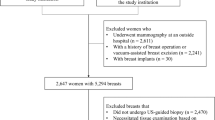Abstract
This study attempts to determine whether intensity windowing (IW) improves detection of simulated calcifications in dense mammograms. Clusters of five simulated calcifications were embedded in dense mammograms digitized at 50-μm pixels, 12 bits deep. Film images with no windowing applied were compared with film images with nine different window widths and levels applied. A simulated cluster was embedded in a realistic background of dense breast tissue, with the position of the cluster varied. The key variables involved in each trial included the position of the cluster, contrast level of the cluster, and the IW settings applied to the image. Combining the ten IW conditions, four contrast levels and four quadrant positions gave 160 combinations. The trials were constructed by pairing 160 combinations of key variables with 160 backgrounds. The entire experiment consisted of 800 trials. Twenty student observers were asked to detect the quadrant of the image in which the mass was located. There was a statistically significant improvement in detection performance for clusters of calcifications when the window width was set at 1024 with a level of 3328, and when the window width was set at 1024 with a level of 3456. The selected IW settings should be tested in the clinic with digital mammograms to determine whether calcification detection performance can be improved.
Similar content being viewed by others
References
Homer MJ: Mammographic Interpretation: A practical approach. New York, NY, McGraw Hill, 1991, pp 4–5
Rosenman J, Roe CA, Cromartie R, et al: Portal Film enhancement: Technique and clinical utility. Int J Radiat Oncol Biol Physics 25:333–338, 1993
Shtern F: Digital mammography and related technologies: A perspective from the National Cancer Institute. Radiology 183:629–630, 1992
Puff DT, Pisano ED, Muller KE, et al: A method for determination of optimal image enhancement for the detection of mammographic abnormalities. J Dig Imaging 7:161–171, 1994
Pisano ED, Chandramouli J, Hemminger BM, et al: Utility of Intensity Windowing in Improved Detection of Simulated Masses in Mammograms of Dense Breasts. Presented at the Radiologic Society of North America Meeting. Chicago, IL, November 27, 1995
McSweeney MB, Sprawls P, Egan RL: Enhanced Image Mammography. AJR 140:9–14, 1983
Smathers RL, Bush E, Drace J, et al: Mammographic microcalcifications: Detection with xerography, screen film, and digitized film display. Radiology 159:673–677, 1986
Chan HP, Doi K, Galhorta S, et al: Image Feature analysis and computer-aided diagnosis in digital radiography: I. Automated detected of microcalcifications in mammography. Med Phys 14:538–547, 1987
Chan HP, Vyborny CJ, MacMahon H, et al: Digital mammography ROC studies of the effects of pixel size and unsharp-mask filtering on the detection of subtle microcalcifications. Investigative Radiol 22:581–589, 1987
Hale DA, Cook JF, Baniqued Z, et al: Selective Digital Enhancement of Conventional Film Mammography. J Surg Oncol 55:42–46, 1994
Yin F, Giger ML, Vyborny CJ, et al: Comparison of Bilateral-Subtraction and Single-Image Processing Techniques in the Computerized Detection of Mammographic Masses. Investigative Radiol 28:473–781, 1993
Yin F, Giger M, Doi K, et al: Computerized detection of masses in digital mammograms: Analysis of Bilateral Subtraction Images. Med Phys 18:955–963, 1991
Pizer SM: Psychovisual issues in the display of medical images. KH Hoehne, ed, Pictorial Information Systems in Medicine. Berlin, Springer-Verlag, 1985, pp 211–234
Revesz G, Kundel HL, Graber MD: The influence of structured noise on the detection of radiologic abnormalities. Investigative Radiol 9:479–486, 1974
Kundel HL, Reversz G: Lesion conspicuity, structured noise and fil reader error. AJR 126:1233–1238, 1976
Revesz G, Kundel HL: Psychophysical studies of detection errors in chest radiology. Radiology 128:559–562, 1977
MacMillan NA, Creelman CD: Detection theory: A user guide. Cambridge, England, Cambridge, 1991, pp 135–136
Author information
Authors and Affiliations
Additional information
Supported by NIH PO1-CA 47982, NIH RO1-65583 and DOD DAMD 17-94-J-4345.
Rights and permissions
About this article
Cite this article
Pisano, E.D., Chandramouli, J., Hemminger, B.M. et al. Does intensity windowing improve the detection of simulated calcifications in dense mammograms?. J Digit Imaging 10, 79–84 (1997). https://doi.org/10.1007/BF03168559
Issue Date:
DOI: https://doi.org/10.1007/BF03168559




